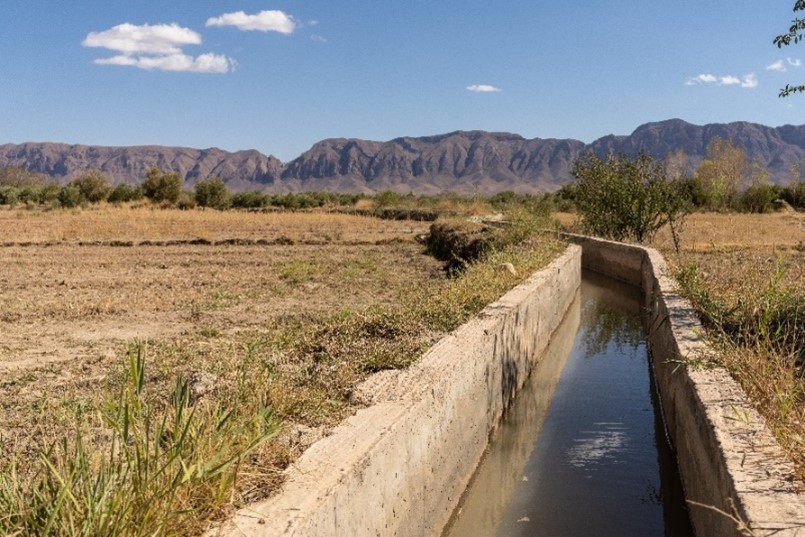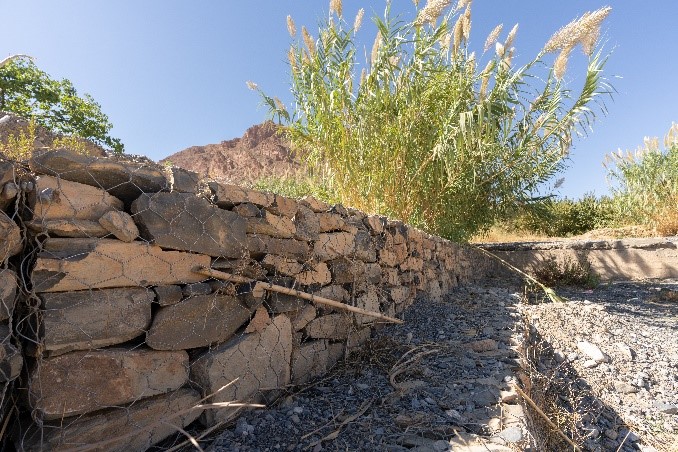
Revitalizing the Drâa-Tafilalet oasis agroecosystems
©FAO/Hassan Chabbi
25/11/2024
The vital oases of Drâa-Tafilalet: sustaining life and heritage in the heart of Morocco’s desert communities
Morocco’s Drâa-Tafilalet region is renowned for its picturesque oases, covering nearly 90 percent of the area, sustaining its resilient, indigenous population and rich cultural heritage. These green havens, abundant with date palms and diverse flora and fauna, are crucial for agriculture and local livelihoods, especially for women, who constitute over 50 percent of the beneficiaries of development initiatives. These initiatives reflect the integral role of oases in promoting gender equality and sustainable development.
Despite their importance, the oases face significant challenges, including population growth, climate change, water scarcity, desertification, and inadequate policies and investments. These factors have led to severe environmental degradation, migration, and a decline in job opportunities. Traditional water management systems, like khettaras, are deteriorating, worsening water shortages. Local biodiversity, including the endangered Yellow Saharan bee, is under threat, and agricultural productivity has declined. To address these challenges, FAO and its partners launched an initiative aimed at reversing these trends and restoring the health of these fragile communities and ecosystems.
Furthermore, seguias - traditional open irrigation channels - have been vital for centuries in the oases of Morocco, channeling water from rivers and underground springs to support agriculture and local communities. Over time, these structures have faced challenges from neglect, climate change and modern farming practices, leading to reduced efficiency and, in some cases, abandonment.


©FAO/Hassan Chabbi
Harnessing information and knowledge for sustainable oasis development
The project is set to deliver benefits long after its operational phase ends. ANDZOA and various ministries have been equipped with essential data, knowledge, and expertise to enhance future planning and actions. Key achievements include comprehensive water accounting for five major watersheds and detailed biodiversity assessments, providing a thorough understanding of local ecosystems. Land erosion and tourism potential have been mapped to pinpoint areas for conservation and development.
The project has also produced five Integrated Sustainable Management Plans, each offering a strategic framework for sustainable development, along with five budgeted investment plans for long-term sustainability. 31 CAPs have been developed to address specific community needs.
Over 15 feasibility studies have been completed, offering actionable insights for various agencies. One study includes a model for revitalizing the khettara system, essential for oasis irrigation, and another explores the reuse of palm waste as animal feed and compost. Wastewater management strategies have been implemented in urban areas like Gourrama and Guers Tiallaline to improve urban water management.
Demonstrating commitment with tangible actions
The project achieved tangible outcomes through direct interventions, fostering community trust and active participation. Stone walls constructed across six municipalities protected 1 200 ha of land, benefiting 9 000 individuals, with over half being women. The rehabilitation of khettaras and seguias across 12 municipalities enhanced irrigation for 4 940 ha, supporting 18 440 people, 55 percent of whom were women. Recognizing the importance of seguias, the project, on the initiative of the Moroccan authorities, has launched rehabilitation projects to restore and preserve these irrigation systems.
Protection measures for pastoral routes, including solar water points and snow shelters, covered 64 000 ha, benefiting 18 820 people. Solar-powered drinking water systems were provided to 1 900 individuals while the Ketaoua water network rehabilitation supported 2 400 inhabitants. Solar energy initiatives for irrigation enabled the cultivation of 1 280 ha, benefiting 6 400 individuals. Solid waste collection in Siroua assisted 1 560 residents, with women comprising over half of the beneficiaries across all these initiatives.

©FAO/Hassan Chabbi
Boosting economic opportunities for smallholders
The project aimed to enhance economic opportunities for smallholders by boosting the resilience, diversity, and sustainability of oasis farming. Central to its success were the people involved, with a strong focus on supporting producer organizations like cooperatives, Economic Interest Groupings, and associations. Capacity building was a core objective, using a value chain approach and emphasizing gender equality.
A notable achievement was the establishment of a specialized centre to protect the Yellow Saharan Bee, a species that has thrived in the Draa-Tafilalet region for 2 000 years and is known for its resilience and gentle nature. The centre has bred over 2 000 queen bees, distributed to local beekeepers to support regional apiculture. In collaboration with UN-WOMEN, the project conducted a study to improve conditions for 1 000 oasis women by exploring digitalization opportunities.
Technical assessments in Toundoute, Iminoulaouene, and Jorf led to the installation of facilities for almond processing and improved date storage, enhancing local agricultural value chains' efficiency and resilience. The project also established composting and biochar production units in Jorf and Aarab Sebbah Gheris, effectively managing date palm waste and promoting sustainable practices. These initiatives contribute to the region's economic and environmental sustainability.
A blueprint for sustainable oasis management
The OASIL project exemplifies a model of excellence in sustainable oasis management, showcasing the profound impact of well-coordinated and sustainable interventions. Through a collaborative effort involving FAO, ANDZOA, the Ministry of Agriculture, the Ministry of Environment, and various partners, the project has revitalized the Drâa-Tafilalet oases. It has empowered local communities to take control of their futures by integrating actionable knowledge, fostering community engagement, and making strategic investments. As other regions face similar challenges, the OASIL project stands as a benchmark for future initiatives, offering a valuable blueprint for preserving and enhancing oasis landscapes in fragile environments.
